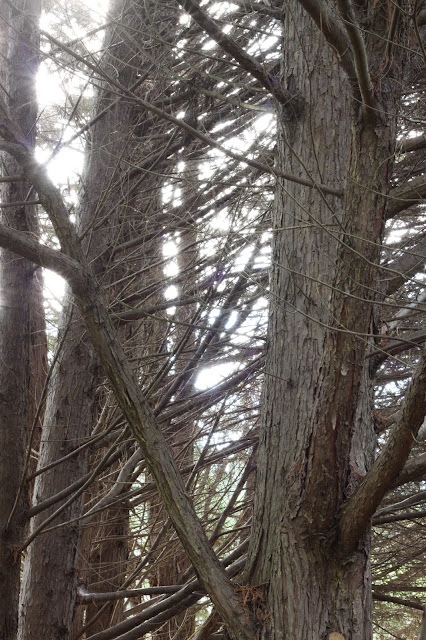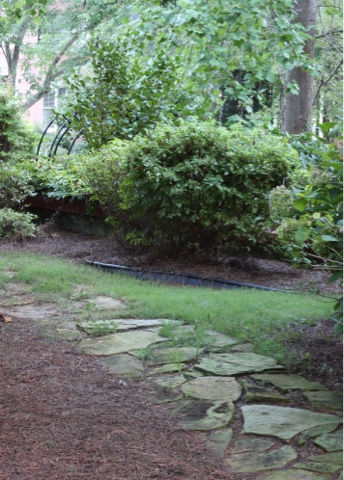While at my grandmother's house, I collected more images from her backyard. As with my mom's yard I focused on details that tell a story of place and time. However, unlike mom's house, I have a long history and deep connection to this place. There, each detail felt like a window into my parent's personalities and everyday life. Here, each detail also reveals something about my grandmother's lifestyle, but it is also steeped in memory, loss, personal history, and change.
Monday, August 29, 2016
Stories in the Details: Grandma's House
While at my grandmother's house, I collected more images from her backyard. As with my mom's yard I focused on details that tell a story of place and time. However, unlike mom's house, I have a long history and deep connection to this place. There, each detail felt like a window into my parent's personalities and everyday life. Here, each detail also reveals something about my grandmother's lifestyle, but it is also steeped in memory, loss, personal history, and change.
Tuesday, August 23, 2016
More Stories in the Details from Mom's House
Whether tending their garden, planting and maintaining their planting beds, or just taking their morning coffee on the deck, both of my parents spend a lot of time outdoors. Their yard is almost like a portrait of their lives. In it, one can discern their love of nature, evidence of a strong work ethic, a predilection for spending time together, and a fondness for keeping aquariums and collecting angels, among other things. One can also find mysteries and curiosities in the same place. This leads me to consider the significance of these details. They are fragments. Each with its own story that when assembled together tells an entirely different one. A story of people, place, home and the reciprocal relationship between woman/man and nature.
Labels:
flora,
garden,
home,
identity,
landscape,
narrative,
nature,
photography,
semester 3,
yard
Monday, August 22, 2016
Reflections - Narrative & Sound

Already this semester has been a major turning point for my work. In addition to returning to the familiar medium of photography, I also plan to continue working with the more recent narration practice and to incorporate a completely new element; using sounds collected from various sources.
For the past couple of weeks, I've been collecting ambient sounds from specific places at various times of the day. I document the name of the place, as well as the date and time the recordings were made. I've also recorded interviews with my mother and grandmother. I consider these sounds, like the photographs I've been taking, raw material to work with once I return home.
Click video below to hear a recording sample of my grandmother's backyard on August 17, at 7:49 pm.
Here is a brief list of goals and ideas in regards to sound and narrative elements in my work:
- Research technical aspects of ambient and viewer initiated sound.
- Rosemarie Trockle and Lynda Benglis
- Continue writing, keep a commonplace book and daily reflectionnaire.
- Think about looping/overlapping narratives vs. voice/movement activated narration (presented as chapters).
- Continue to record writings and experiment with different methods of storytelling.
- Record interviews with family (perhaps people I meet during trip to Harris County).
- Do a lot reading, like, a lot. Academic/non-fiction and lift my self-initiated ban on fiction that I started at the beginning of the program.
- Consider reading a play or two
- Collect moving images for use in installation.
Sunday, August 14, 2016
Stories in the Details
I was recently inspired by two photographs, Circus Signboard by Walker Evans and Tombstone 3 by Aaron Siskind. Although I've always been a fan of the narrative qualities of Evan's work, I was not aware of this particular series of wall images. Simple, yet profound in composition, this piece tells stories about people, place, and time, simultaneously. While Siskind may have been more concerned with formal abstraction, the resulting narrative is similar. I am fascinated with the idea of telling a story with a minimal amount of information, allowing the viewer to more actively engage in the storytelling process. It reminds me the what I love most about reading; using tools provided by the author to activate my own imagination.
When photographing my mother's backyard, I kept these two images in mind. When deciding what to shoot, I asked myself what story I was trying to tell and which images would best serve as a catalyst for guiding the viewer into that story.
Friday, August 12, 2016
Objects, Labor, & Identity: Mom and her Cross-stitching
I see this photo series as a continuation of the object series I started last semester where I cast the negative space created by specific gestures to create organic, shell-like objects. My mom has always been creative. When I was young, she ran a home-based sewing business. Some of my earliest memories are of watching her work or going fabric shopping with her. Although she has taken up cross-stitching recently, observing her creative process feels like a memory that has come full circle. This series also picks up the branching line visual motif that I started using last semester.
Three Distinct Worlds in One Yard
This is a collection of detail shots I've taking in my grandmother's backyard. There seems to be three distinct zones: the far side of the yard beneath the tree line that is nearly abandoned, yet full of relics of past use, the manicured lawn that is closest to the house, and still in use, and beyond the fence where nature is more wild and the ravine and creek divide our yard from our neighbors to the rear.
Thursday, August 11, 2016
Sardis and Prospect
While exploring the back roads of Harris County in the area that would have been known as Negro Heel in 1850, we passed a winding yet unassuming, tree-lined drive. Something called to me from the end of that drive. I asked my husband to back the car up and drive down. I could see a small rocky formation in a clearing at the end of it. In truth, I hoped it could be the ruins of a home or ancient church, but what we found was a cemetery. This cemetery seemed abandoned and partially destroyed. However, the freshly mown grass surrounding it and an empty beer can alerted me to the fact that someone knew it was here.
While looking around, I discovered some familiar names. Isaiah Jr.'s elder brother, Fleming, and his wife, Rebecca. This was a huge discovery. Before the probate records I hadn't paid much attention to Fleming because he was not in my direct line. I'm paying attention now though because after reading the documents we found in the court house, he seemed so much closer to Isaiah.
In the same year that Isaiah Sr. died, Georgia seceded from the Union. Fleming, who according to his gravestone, enlisted in the Confederate Army was also knee deep in court proceedings concerning his father's estate along with his younger brother. By the end of those proceedings, Isaiah had brought for himself a slave that he fathered 3 children with and intended to live with (illegally) as husband and wife. I can almost imagine the tension that might have been caused by such an act during that time.
Unfortunately, I could not locate any other blood relations in Sardis cemetery, although I did find Thomas, who married Fleming and Isaiah's sister. There was, however, a large number of unmarked rock graves. Could they contain Isaiah Jr. or his parents?
After leaving Sardis, we headed to Prospect Church. I remember visiting this cemetery with my grandmother as a child. Charity Ann and her eldest daughter, Virginia whom my grandmother is named after and who was the only surviving child Isaiah Jr. purchased in 1861, are buried there. My grandmother told me that because Charity Ann was not white, she and Isaiah could not be buried together. No one in my immediate or extended family knows where he rests.
Subscribe to:
Posts (Atom)


























































